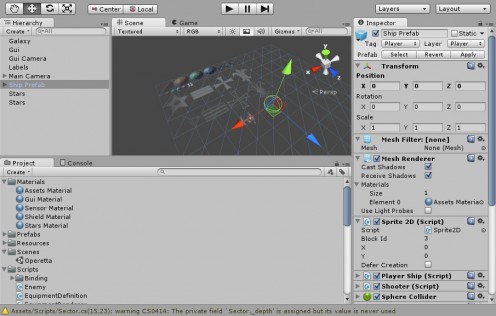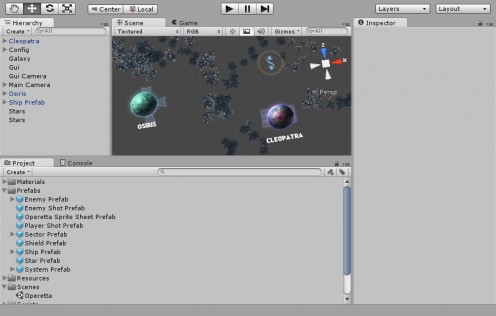On some basic level, most programming languages are kind of the same.
Until they’re not.
Sure, ifs are ifs and loops are loops no matter what the syntax, but development environments can vary greatly in terms of how they want you to work. And if you fight that, you can be making things way harder on yourself than you need to.
I’ve recently run into this with Unity.
I picked up Unity because I was tired of trying to make games in environments designed for writing apps. And I loved it. Unity has a really nice library that contains functions for editing meshes, writing shaders, and working with object relationships in three dimensions.
However, this is what Spindle Sun looked like, in Unity:
It… didn’t look like anything at all. There are no spaceships, no planets, no game board to look at. Just an anonymous sprite sheet, which is an artifact of the way I was approaching everything: everything was made in code. When you started the game, it would randomly make some planets, and give them random names, and put you in the center of the map… but you couldn’t see any of that in the editor. And it was hard to imagine, looking at the editor, what was going on, what the gameplay might be like.
So I’ve decided to ditch the procedural maps thing and just make a level in Unity’s very nice level editor, and this is what editing looks like now:
Here, you can see a couple planets. They have names in the Hierarchy list and in the Scene preview. There are stars, and you can see your spaceship’s starting position.
Spindle Sun is sort of a spin on 4x take-over-the-galaxy games, and you sort of expect those to be procedural. But I’m working out the gameplay as I go, and doing that with a procedural world has proven to be rather annoying. What I need to really get the gameplay right is a concrete map, so I can look at it and see what sorts of challenges the player will face and what obstacles I can put in their way and see how the player is going to progress through the map.
It’s about being able to work hands-on with the design of the game. Which, previously, I wasn’t really doing.
I’ve tried studying levels in other games like Metroid Prime, but I’ve never actually designed a level before, in a level editor. Most stuff I’ve done has been procedural, or I’ve made little maps you could walk around that weren’t really levels in the sense that there was a flow through the level. So all this is new to me.
Unity is much more than a code library, and I’m pretty sure Unity wants you to work in a visual sort of way. And I’m rather liking it so far.

